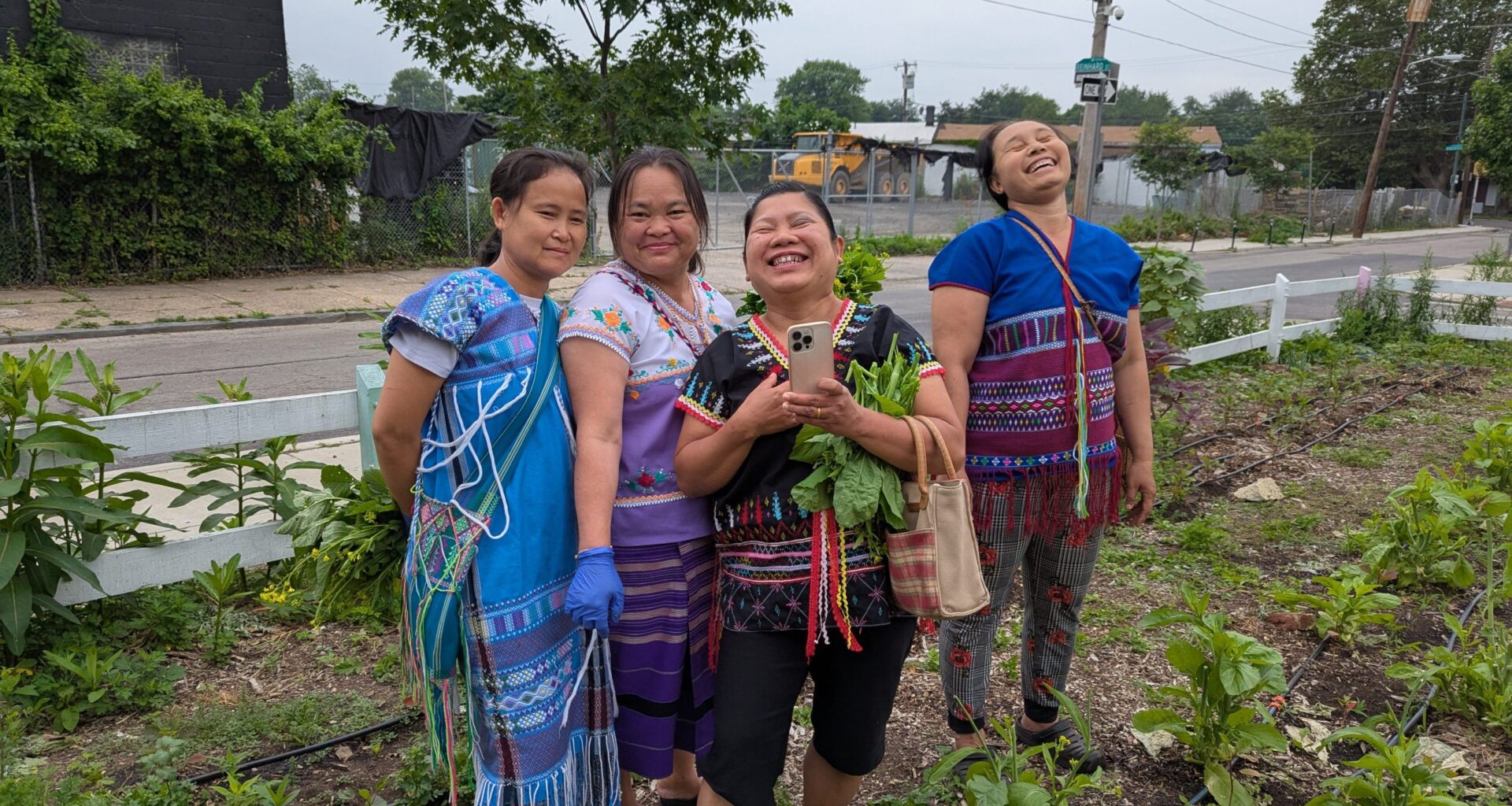Editor’s note: Some quotes have been translated from the S’gaw Karen language and edited for clarity and readability.
At the Bok building in South Philadelphia, 87-year-old refugee Gay Lay reflected on the weight civil war has taken on her life.
For over two decades — starting in her twenties — she was living and hiding in Myanmar jungles. She moved from location to location with a small group to evade the Burmese army, after soldiers had burned down her village. Sometimes, they slept in trees. If she was caught, the consequences could mean detention, sexual violence or death.
“My whole life, I had to be afraid of everything,” she said. Her English is limited, so she told the story in her native language of S’gaw Karen, through a translator.
Gay Lay is a Karen refugee. Karen (pronounced kuh-REN) people are a minority ethnic group from Myanmar (formerly Burma). Since Myanmar’s independence from Britain in 1948, the country’s government has worked to impose a single national identity — marginalizing and persecuting ethnic minorities like her.
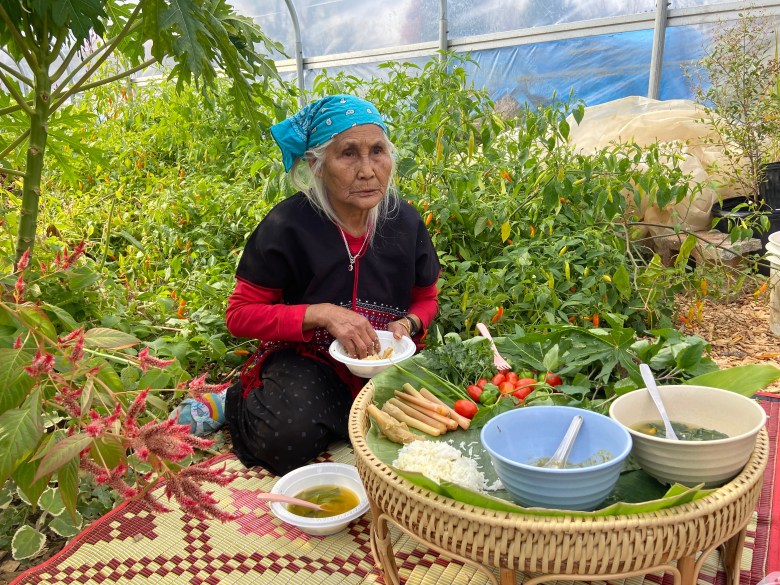 Gay Lay at a garden in Philadelphia. (Courtesy of Clara Varadi-True)
Gay Lay at a garden in Philadelphia. (Courtesy of Clara Varadi-True)
Many pivotal moments of Gay Lay’s life took place in the jungle. She recalled learning of her husband’s death. He had been conscripted — like all Karen men — to fight against the Burmese army. At the time, she was five months pregnant and already a mother to five.
While her first four children had been delivered in her village, this would be her second pregnancy to give birth virtually alone and in the jungle. At this point, she had already learned how to keep a newborn’s cries quiet by holding them close to her chest, rocking and covering them.
“Like a hen, you had to pull all your kids around you,” she said.
Gay Lay’s children grew up in the jungle. The family farmed to eat, and moved constantly, living out of temporary bamboo houses. When they did so, they were always listening for the enemy.
“Even though you had food, you had to hide it,” she explained. Her family would wait until night time to retrieve their food.
Gay Lay has been living in Philadelphia since 2010. In South Philly there is a whole community of Karen people with stories like hers. Unfortunately, many of us don’t even know they’re here.
Who are Karen people?
Karen people are not a monolithic group, but are culturally diverse, with different religions and even languages.
“Karen people first started coming to the U.S. as refugees, around 2006, so there aren’t many generations of people who’ve been living in Philadelphia,” said Rebecca Winkler, a sociocultural anthropology Ph.D candidate at the University of Pennsylvania. She is also a founder of the Karen Community Association of Philadelphia (KCAP), a new organization that began last March, to help Karen community members.
“In Southeast Philly — like East of Broad, South of Oregon — there’s around 500 people in that area,” Winkler said.
The exact number of Karen people in the city is unknown. Part of the KCAP’s work is to gather better demographic facts about the Karen population in Philadelphia, who are often mislabeled in census data.
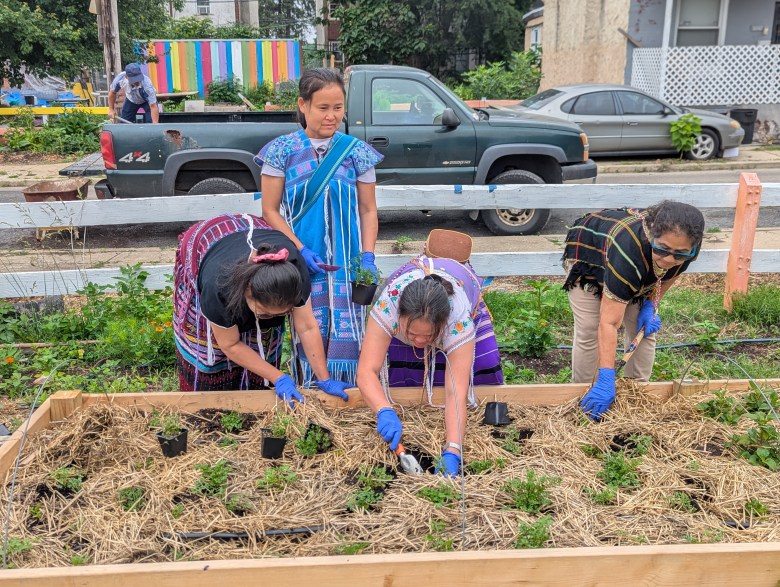 Gardening at the Reinhardt Street Community farm. (Courtesy of Clara Varadi-True)
Gardening at the Reinhardt Street Community farm. (Courtesy of Clara Varadi-True)
“We’re trying to work on doing a more comprehensive kind of needs assessment, because people don’t get counted as Karen, they get counted as Burmese, and then are often offered services in Burmese,” she said. “But Burmese is, quite literally, the language of the army that caused people to have to be refugees.”
And because they are such a niche and small population in the city, their needs often fall between the cracks. The KCAP was created to fill those gaps — helping Karen people navigate government forms and Social Security, as well as their legal and medical needs. In addition, the association organizes community events around the city.
It is a small operation that comprises Winkler and two Karen women: Naw Day and Naw Doh. As two of the rare English speakers of their generation, Naw Day and Naw Doh have become designated helpers in their community. In fact, it was actually Naw Doh who translated our interview with Gay Lay.
“We know what our Karen people need,” Naw Day said. “I’ve been trying to help in the past decade with free translation, social service needs … We don’t have really the structure to build our community, right? So we try to volunteer.”
“We’re only three of us right now — Rebecca, me and Naw Doh,” she added. “We don’t have much [support], but I would say we have a lot of things to do.”
Immigration and culture shock
To come to the United States, many Karen people first made the journey across the Thai border to find safety in refugee camps. They are often there for years. Gay Lay and her family spent around a decade at one, before coming to the United States.
“People were in prolonged displacement for many years, and the refugee camps in Thailand are not really official refugee camps,” Winkler said. “They’re in the jungle in Thailand, so people had to kind of build their own homes out of bamboo and try to forage and farm for things, and had very limited opportunities to do any kind of formal education.”
As one can imagine after living in the Southeast Asian jungles for decades, starting over in South Philadelphia is an intense culture shock.
A video of Gay Lay with her daughter by Shira Walinsky (Mural Arts)
“People arrived to Philadelphia and are suddenly inundated with all of this technology and the refugee resettlement infrastructure in the United States has been really kind of chipped away at over the last like decade or two,” Winkler said. “It used to be that people, when they arrived, got between two and three years of support from a caseworker, cash payments every month, support, learning English, resettling, finding a job,” she added. “And now that’s been stripped down to just three months.”
People like Gay Lay may have been experts in survival, but all of the farming, foraging, weaving and building skills gained in the jungle are suddenly useless in the city — leaving many Karen people feeling helpless.
Htee Da Win, a 36-year-old Karen woman, recalls the first time her case worker dropped her off at her new home in South Philadelphia in 2009. Naw Doh translated her story. It was night and the neighborhood felt foreign and unfamiliar. She had been instructed to keep her doors locked. Even though the place had multiple bedrooms, she, her husband and her two young children all slept in the living room. They were afraid to separate.
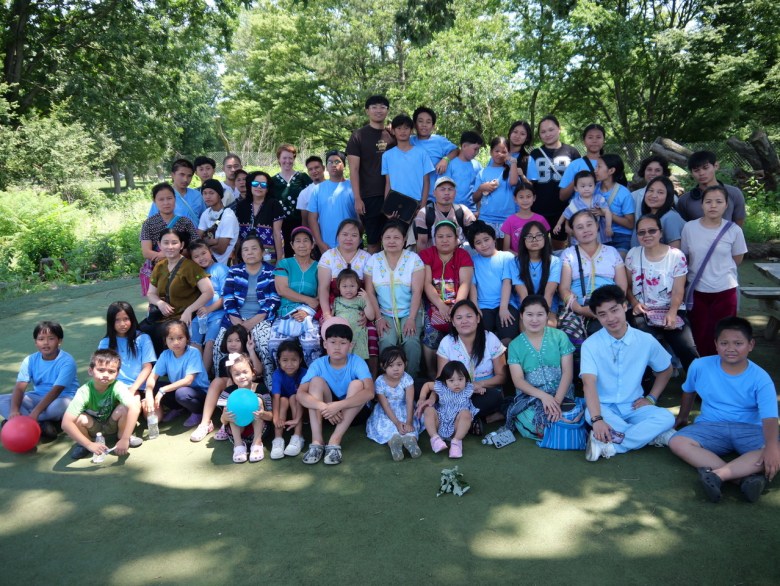 Many Karen people spent decades hiding in jungles before coming to the United States. (Courtesy of Rebecca Winkler)
Many Karen people spent decades hiding in jungles before coming to the United States. (Courtesy of Rebecca Winkler)
“We were really scared,” she said. “We immediately turned off the lights, because we didn’t want anyone to see us.”
Even though Htee Da Win’s family was given food, including rice, when she arrived, they didn’t know how to use the stove.
Naw Doh, explained that this is a common problem. Three months is not enough time for a family to orient themselves to a new culture. She said she used to have to hide in her house, because she received so many requests from community members for help. As a woman, saying no to a request isn’t really an option in Karen culture.
“I turn out my light. I go upstairs,” she said. “If they see the light, they’ll come knock on my door.”
Establishing a new home
Once a week the KCAP offers office hours to community members at the Bok building, from a room provided and leased by Mural Arts. Anyone who is Karen can come and receive help.
Community members like Htee Da Win, whose husband recently died from a stroke. Like many Karen immigrants, he worked at a meat processing factory, a very physically demanding job that involved butchering, deboning and cutting beef.
Htee Da Win said that her husband was feeling pain, but ignored it because he did not want to miss out on work — and pay.
“He didn’t want to miss his job. He didn’t want to see the doctor,” she said. “You know as a refugee, you have to pay the rent. You have to work.”
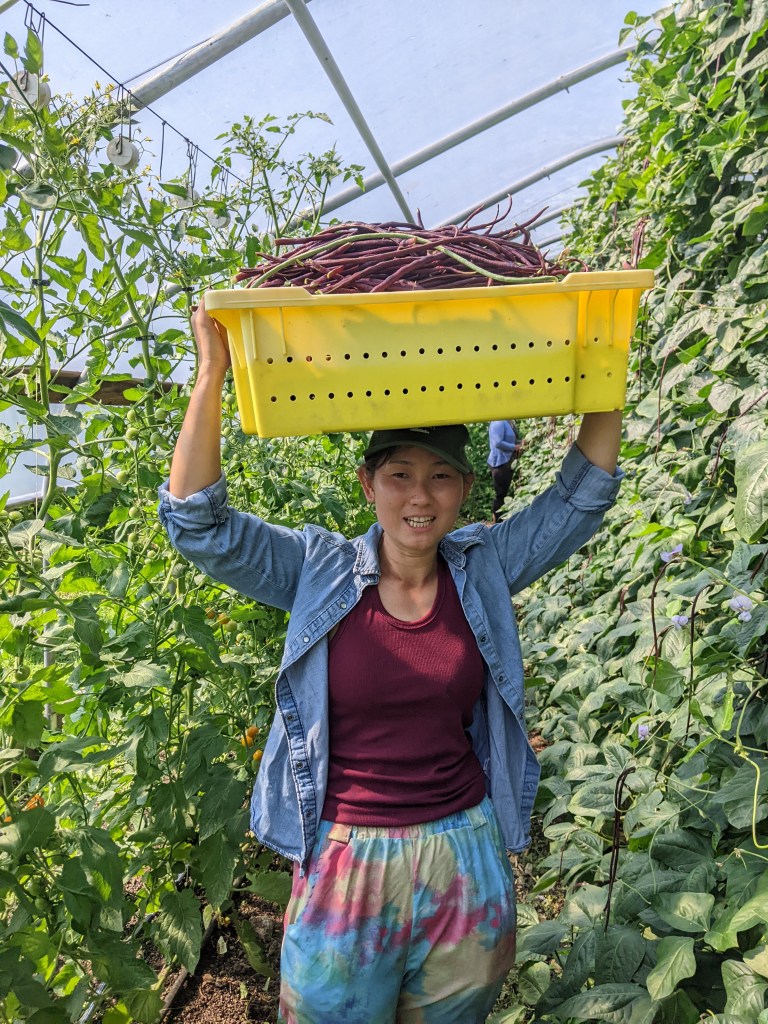 Htee Da Win at a community farm. (Courtesy of Clara Varadi-True)
Htee Da Win at a community farm. (Courtesy of Clara Varadi-True)
The KCAP is helping her navigate life as a widow — assuring that her family receives all the life insurance funds they are due.
Despite her family’s loss, Htee Da Win is still grateful to live in Philadelphia.
“I count my blessings,” she said, noting the government programs that have helped her, like food stamps. “Recently my son received a college scholarship.” She added that she is also grateful for the KCAP and her community in the city.
The KCAP also works with Karen children that were either born in or spent the majority of their lives in the United States, to make sure that their language is being passed down. Naw Doh leads S’Gaw Karen classes.
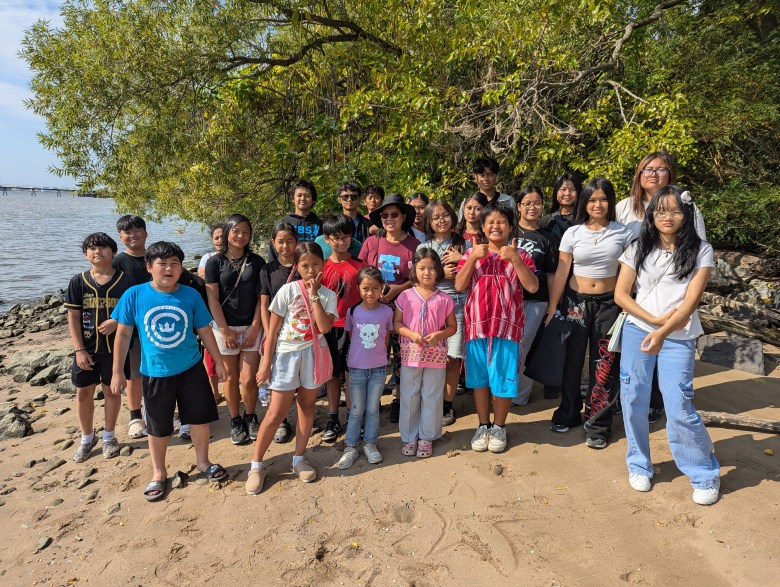 Naw Doh with a group of Karen children at the beach. (Courtesy of Clara Rebecca Winkler)
Naw Doh with a group of Karen children at the beach. (Courtesy of Clara Rebecca Winkler)
“They need to learn, because one year the Karen language could be gone,” she said, noting that some Karen children have lost touch with the language and can’t communicate with their parents. “It’s really scary.”
In addition to the translation and social services that KCAP provides, the association also helps set up community events around Philadelphia for Karen people. Many of them are avid gardeners and grow their native foods in their backyards and also at community farms, like Reinhardt and Novick.
“The garden is very important for us”
In late September, on a sunny Saturday afternoon at FDR Park, the KCAP organized a potluck for the community — offering fruits and foods that you’ve likely never heard of. There were sour leaves and hyacinth beans. Kids played and ran around.
“Everything they grow is tropical, Southeast Asian vegetables,” said Clara Varadi-True, the director of operations at Novick Urban Farm. The Farm has been working with Karen people for over a decade.
“Philadelphia is really hot and humid,” Varadi-True explained. “I think it’s a great answer to climate change. That’s been what I’ve been talking about for the last few years, is that some of these vegetables grow better than traditional American vegetables in dirt.”
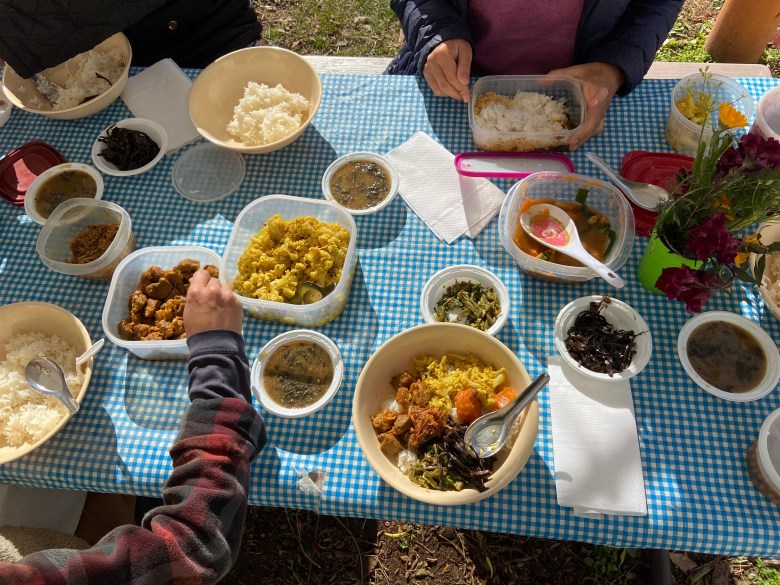 A potluck with foods made by the Karen community. (Courtesy of Clara Varadi-True)
A potluck with foods made by the Karen community. (Courtesy of Clara Varadi-True)
At the potluck, there was an array of fried foods, meats, veggies, salads, noodles and spicy sauces. Working with soil is an important way for Karen people in the city to maintain culture and find connection with their home.
“The garden is very important for us,” Naw Day said. “It makes us happy.”
For Gay Lay, farming and growing produce is essential. She has 19 grandchildren, and nine great grandchildren. She is an avid farmer, working with Reinhardt Garden. She also has a plot in her backyard.
“I love everything. I want to plant everything,” she said. “In my backyard. I squeeze in everything, even in tight corners.”
While the KCAP is still new, working with other organizations and giving Karen people the support they need has been impactful. Winkler said that even though their funding is limited, Karen community members like Naw Doh and Naw Day have worked hard to improve lives.
“It seemed really important for folks to be able to lead their own organization,” she said. “When communities are actually given resources themselves and can decide how to distribute them, and they’re actually on the ground and part of the community that they’re serving, they can do incredibly effective work.”
